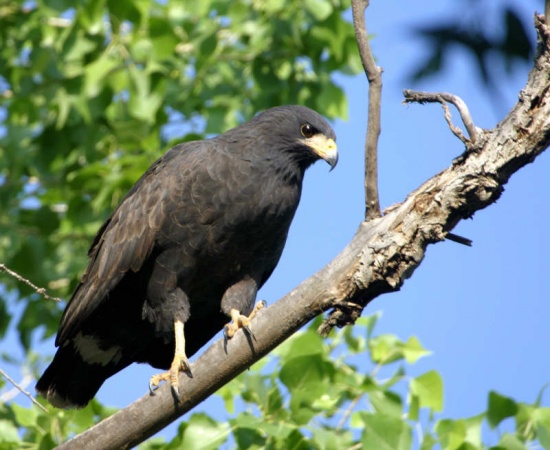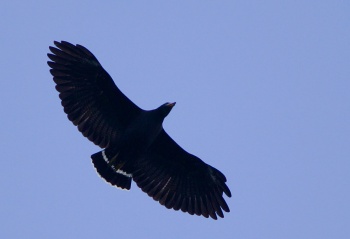m (→Taxonomy: spec) |
(taxon) |
||
| (11 intermediate revisions by 5 users not shown) | |||
| Line 1: | Line 1: | ||
| − | + | [[Image:Common_Black_Hawk.jpg|thumb|550px|right|Photo by {{user|bobsofpa|bobsofpa}}<br />[[Big Bend National Park]], [[Texas]], [[USA]], March 2004]] | |
| − | [[Image:Common_Black_Hawk.jpg|thumb|550px|right|Photo by bobsofpa<br /> | + | ;[[:Category:Buteogallus|Buteogallus]] anthracinus |
| + | '''Includes: Mangrove Black Hawk''' | ||
| + | ==Identification== | ||
| + | [[Image:Mangrove_Black_Hawk.jpg|thumb|400px|right|Mangrove Black Hawk<br/>Photo by {{user|rb_stern |rb_stern }}rb_stern <br/>Playa Blanca, [[Panama]] ]] | ||
| + | Length 50-58cm (20-23"), wingspan 122-127cm (48-50")<br /> | ||
| + | As the name implies, this is a very dark hawk; dark brown to almost black, with a yellow bill tipped in black, and some white spotting on the base of the primary flight feathers, and at the tip of the tail. In its limited US range, it is most easily identified by chunky shape and broad white band crossing middle of tail. Notice the variation: width of the white tail band varies geographically. | ||
| − | == | + | ====Similar species==== |
| − | + | Further south compare the [[Great Black Hawk]] and the rare [[Solitary Eagle]]. | |
| − | |||
==Distribution== | ==Distribution== | ||
| − | Found in coastal regions of northern and north-western South America, incl. Trinidad & Tobago, north through Central America and Mexico, to southernmost USA (Arizona and Texas). Generally resident, but some local movements, and only a summer visitor to south-eastern Arizona. Also seen along border section of Rio Grande River, notably in Big Bend NP, in winter. Very rare visitor to lower Rio Grande Valley, Texas | + | Found in coastal regions of northern and north-western [[South America]], incl. [[Trinidad]] & [[Tobago]], north through [[Central America]] and [[Mexico]], to southernmost [[USA]] ([[Arizona]] and [[Texas]]). Generally resident, but some local movements, and only a summer visitor to south-eastern Arizona. Also seen along border section of Rio Grande River, notably in Big Bend NP, in winter. Very rare visitor to lower Rio Grande Valley, Texas. |
| − | + | ====Conservation Status==== | |
| − | [[Image: | + | [[Image:4381Common Black Hawk in flight.jpg|thumb|350px|right|Photo by {{user|Steve+G|Steve G}}<br />Arima Valley, Northern [[Trinidad]], May 2006]] |
| + | Overall common and widespread. In its limited US range it is rare and local, with an estimated 250 breeding pairs remaining. | ||
| + | ==Taxonomy== | ||
| + | Recent evidence has led the population on Cuba to be considered a separate species, the [[Cuban Black Hawk]] (''Buteogallus gundlachii''). However, the Mangrove Black Hawk (''B. subtilis'' including subspecies ''rhizophorae'' and ''bangsi'') is now included in Common Black Hawk as three subspecies. | ||
| − | == | + | ====Subspecies==== |
| − | + | [[Image:Img 7366-22.jpg|thumb|350px|right|Juvenile<br />Photo by {{user|xyz99|xyz99}}<br />Peninsula Osa, [[Costa Rica]], February 2009]] | |
| + | There are 5 subspecies<sup>[[#References|[1]]]</sup>: | ||
| + | *''B. a. anthracinus'': | ||
| + | :*South-western [[US]] to northern [[South America]], St. Vincent and [[Trinidad]] | ||
| + | *''B. a. utilensis'': | ||
| + | :*Cancún, Cozumel Island and islands in Gulf of Honduras | ||
| + | *''B. a. rhizophorae'': | ||
| + | :*Pacific coast of [[El Salvador]] and [[Honduras]] | ||
| + | *''B. a. bangsi'': | ||
| + | :*Pacific coast of [[Costa Rica]] and [[Panama]]; Pearl Islands | ||
| + | *''B. a. subtilis'': | ||
| + | :*Pacific coast of [[Colombia]], [[Ecuador]] and extreme northern [[Peru]] | ||
==Habitat== | ==Habitat== | ||
Wide range of wooded habitats, especially in coastal areas. In the northernmost parts of its range, nests most commonly in cottonwood trees in riparian areas. | Wide range of wooded habitats, especially in coastal areas. In the northernmost parts of its range, nests most commonly in cottonwood trees in riparian areas. | ||
| − | |||
==Behaviour== | ==Behaviour== | ||
Gentle and lethargic except while nesting, when it often drops out of the skies from great height. | Gentle and lethargic except while nesting, when it often drops out of the skies from great height. | ||
| − | + | ====Breeding==== | |
| − | == | + | It builds a large stick nest in a tree, and usually lays one dark-blotched whitish egg. Will abandon nest if disturbed too much. |
| − | + | ====Diet==== | |
| − | + | Diet includes crabs, and small vertebrates and eggs. | |
| + | ==References== | ||
| + | #{{Ref-Clements6thAug11}}#{{Ref-GillDonsker10}} | ||
| + | {{ref}} | ||
==External Links== | ==External Links== | ||
{{GSearch|Buteogallus+anthracinus}} | {{GSearch|Buteogallus+anthracinus}} | ||
| − | [[Category:Birds]] | + | <br /> |
| + | {{Video|Common_Black_Hawk}} | ||
| + | [[Category:Birds]][[Category:Buteogallus]] [[Category:Videos]] | ||
Revision as of 19:17, 3 September 2015
- Buteogallus anthracinus
Includes: Mangrove Black Hawk
Identification
Length 50-58cm (20-23"), wingspan 122-127cm (48-50")
As the name implies, this is a very dark hawk; dark brown to almost black, with a yellow bill tipped in black, and some white spotting on the base of the primary flight feathers, and at the tip of the tail. In its limited US range, it is most easily identified by chunky shape and broad white band crossing middle of tail. Notice the variation: width of the white tail band varies geographically.
Similar species
Further south compare the Great Black Hawk and the rare Solitary Eagle.
Distribution
Found in coastal regions of northern and north-western South America, incl. Trinidad & Tobago, north through Central America and Mexico, to southernmost USA (Arizona and Texas). Generally resident, but some local movements, and only a summer visitor to south-eastern Arizona. Also seen along border section of Rio Grande River, notably in Big Bend NP, in winter. Very rare visitor to lower Rio Grande Valley, Texas.
Conservation Status
Overall common and widespread. In its limited US range it is rare and local, with an estimated 250 breeding pairs remaining.
Taxonomy
Recent evidence has led the population on Cuba to be considered a separate species, the Cuban Black Hawk (Buteogallus gundlachii). However, the Mangrove Black Hawk (B. subtilis including subspecies rhizophorae and bangsi) is now included in Common Black Hawk as three subspecies.
Subspecies
There are 5 subspecies[1]:
- B. a. anthracinus:
- South-western US to northern South America, St. Vincent and Trinidad
- B. a. utilensis:
- Cancún, Cozumel Island and islands in Gulf of Honduras
- B. a. rhizophorae:
- Pacific coast of El Salvador and Honduras
- B. a. bangsi:
- Pacific coast of Costa Rica and Panama; Pearl Islands
- B. a. subtilis:
Habitat
Wide range of wooded habitats, especially in coastal areas. In the northernmost parts of its range, nests most commonly in cottonwood trees in riparian areas.
Behaviour
Gentle and lethargic except while nesting, when it often drops out of the skies from great height.
Breeding
It builds a large stick nest in a tree, and usually lays one dark-blotched whitish egg. Will abandon nest if disturbed too much.
Diet
Diet includes crabs, and small vertebrates and eggs.
References
- Clements, JF. 2011. The Clements Checklist of Birds of the World. 6th ed., with updates to August 2011. Ithaca: Cornell Univ. Press. ISBN 978-0801445019. Spreadsheet available at http://www.birds.cornell.edu/clementschecklist/downloadable-clements-checklist
- Gill, F and D Donsker (Eds). 2010. IOC World Bird Names (version 2.7). Available at http://www.worldbirdnames.org/.
Recommended Citation
- BirdForum Opus contributors. (2024) Common Black Hawk. In: BirdForum, the forum for wild birds and birding. Retrieved 27 April 2024 from https://www.birdforum.net/opus/Common_Black_Hawk
External Links







